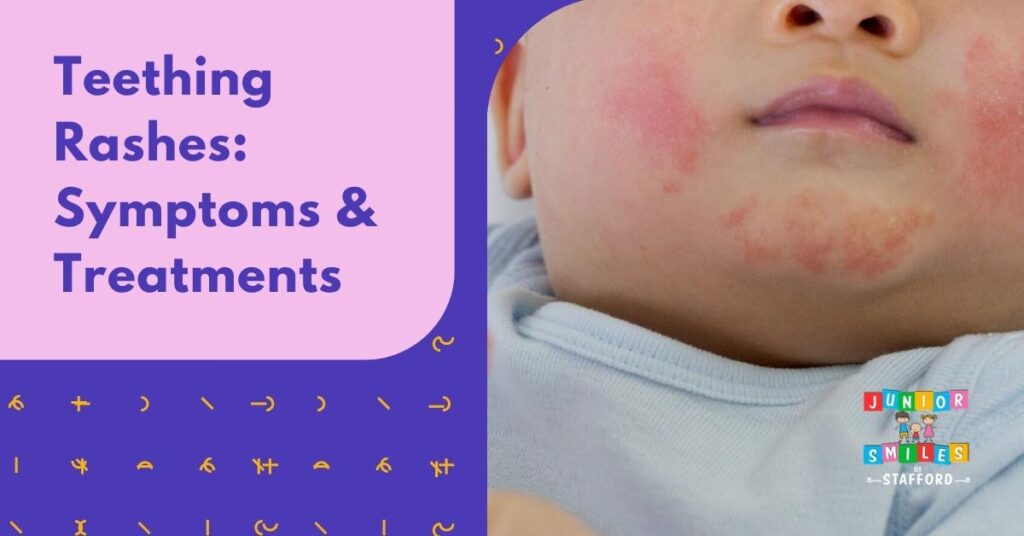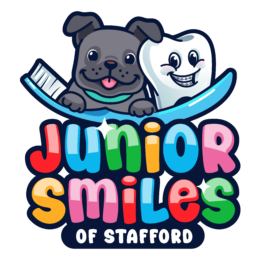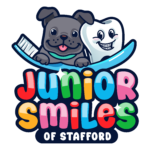Teething Rashes: Symptoms and Treatments

In the early stages of childhood, one of the most common rites of passage is the emergence of teeth. As your little one’s first teeth push through their gums, they may experience some teething symptoms such as fussiness, swollen gums, and even a rash. Is the teething process the direct cause of this rash? The question at hand is how to alleviate the discomfort of a rash brought on by teething.
While it can be alarming to see your child with irritating rashes, there are several things you can do to help ease their discomfort and treat the rash
In this blog post, we will discuss the different types of rashes that can occur during teething, as well as some tips for how to treat them. Keep reading for more information!
What is a Teething Rash?
Teething rash is a common symptom that babies experience during the baby teething phase. It typically manifests as reddish, irritated skin around the mouth, cheeks, and sometimes extends to the neck area. This condition is primarily due to the excess saliva or excess drool that teething triggers and the constant wetness on sensitive baby skin.
What Does a Teething Rash Look Like?
Teething rash has distinct characteristics, setting it apart from other skin conditions. Here’s a closer look at its appearance:
Mild Redness
The first sign is often a gentle reddish hue around the baby’s mouth and cheeks. This redness signals irritation from constant drool exposure. Over time, without intervention, this redness can become more pronounced, causing dry skin or scaly skin.
Chapped Skin
The skin may resemble the dryness we associate with chapped lips. This is due to the drying effect of saliva, especially when it’s left to evaporate, making the skin dry. Cold weather or arid climates can exacerbate this chapped appearance.
Rough Patches
Persistent wet-dry cycles can lead to the skin developing rough, slightly raised patches. These areas are not only visibly different but also have a bumpy texture. The irritation can make these patches stand out against the surrounding sensitive skin.
Warmth
Inflamed or irritated skin often feels warm to the touch. This warmth is a natural response of the body to skin irritations. Parents may notice this when comforting or cleaning their baby’s face, indicating a mild rise in temperature.
Recognizing these signs of teething enables timely care and intervention, ensuring that your little one remains as comfortable as possible during this teething phase. And, as always, when uncertain about any symptom, it’s best to seek advice from a pediatric dentist.
What Are The Causes of Teething Rash?
Understanding the triggers behind a teething rash is essential in effectively managing and preventing it from worsening.
Excessive Drooling
When babies teethe, they tend to drool significantly, and this excessive saliva can irritate their gentle skin. The drool removes moisture from the skin, leaving it vulnerable to irritations and cracking. This reaction is one of the primary reasons teething babies are prone to developing rashes around their mouth during teething and neck area.
Friction
Friction exacerbates teething rash, often caused by babies rubbing their faces against various objects. When the already vulnerable skin comes into contact with surfaces like crib sheets, toys, or even their little hands, the area can become more irritated. Parents may notice the rash appears worse in areas where skin frequently rubs against these surfaces.
New Foods
The introduction of new foods in a baby’s diet often coincides with the teething phase. Some foods may cause mild irritation to the skin, especially acidic ones, when they mix with drool and remain on the baby’s face. This sensitivity can contribute to the appearance or exacerbation of teething rash, making it essential to clean the baby’s face after meals.
What Are Common Teething Symptoms?
Recognizing the signs of teething can help caregivers provide timely relief and comfort during this often uncomfortable phase for babies.
Drooling
Increased drooling is often the precursor to new teeth arriving soon. This natural response can start months before the first tooth even appears, serving as a primary indicator of the teething stage. However, the excess saliva can contribute to skin irritation, leading to teething rash.
Irritability
Teething is often uncomfortable for babies, causing a noticeable change in their mood and behavior. The discomfort from emerging teeth beneath the gums can result in babies being fussier and more prone to crying, especially during the late afternoon and night when distractions are fewer. Recognizing this irritability can help parents provide the necessary comfort and relief.
Chewing on Objects
The pressure of teeth pushing through the gums is often relieved when babies chew on objects. This behavior can be a clear sign of teething, serving as their way to counteract the pressure from below the gums. It’s essential to provide safe, teething-approved objects for babies to chew on to prevent any injury or ingestion of harmful substances.
What Are Home Treatments For Teething Rash?
Simple, soothing care at home can significantly alleviate the discomfort caused by a teething rash and promote faster healing.
Gentle Cleansing
Regular and gentle cleansing is vital to keeping the irritated areas clean and free of further irritants. Using a soft cloth, parents should dab away drool without causing friction on the baby’s sensitive skin. A mild baby soap and lukewarm water can help in cleaning the area during bath time without exacerbating the irritation.
Barrier Cream
Using a barrier cream can help protect the delicate skin affected by teething rash. A protective ointment or barrier cream specifically designed for babies can be applied to provide a protective seal against further irritation. This approach helps in preventing the drool from directly affecting the skin, reducing the likelihood of the rash worsening.
Dryness
Maintaining dryness around the affected area is essential in managing teething rash. This means changing drool-soaked clothes, using absorbent bibs, and gently patting the area dry throughout the day. By keeping the skin dry, parents can help prevent additional irritation from prolonged moisture exposure.
When To See A Doctor
If the rash persists, worsens, or if there are signs of infection like fever, pus, or increasing pain, it’s crucial to seek medical attention. Additionally, if your baby is inconsolable or the teething symptoms cause eating or sleeping issues, a pediatrician should assess the situation to rule out any complications or concurrent illnesses.
Frequently Asked Questions
What does a baby’s mouth look like when teething?
Rosy-red cheeks are a common sign of teething. Your baby’s cheeks go red because they are drooling more than usual, and the saliva irritates their skin. Teething can also cause your baby to be cranky and to have trouble sleeping. If you think your baby is teething, you can try giving them a cold, wet cloth to chew on or a teething ring. You can also rub their gums with your finger. If your baby is in a lot of pain, call your doctor immediately.
Can teething cause blisters on the lips?
It is not typical for teething to cause blisters on the lips. However, it is possible for teething to cause a slight increase in temperature, and for the gums to be swollen and red. If these symptoms are accompanied by blisters on the lips, then it is likely that the blisters are related to teething.
Read more: Can A Child Get Braces With Baby Teeth?
Contact Junior Smiles Of Stafford To Know More About Your Baby’s Teething Process
If you have any questions about your baby’s teething process or want to know more about what to expect, please do not hesitate to contact a reputable dentist like Junior Smiles of Stafford. Our dentists and staff are experienced in helping parents through this exciting time in their child’s life and will be happy to answer any questions you may have. We look forward to welcoming your family into our practice!
Contact us now to learn more about your baby’s teething journey and discover how we can support you and your little one during this exciting time. We’re looking forward to being a part of your family’s dental health journey!

